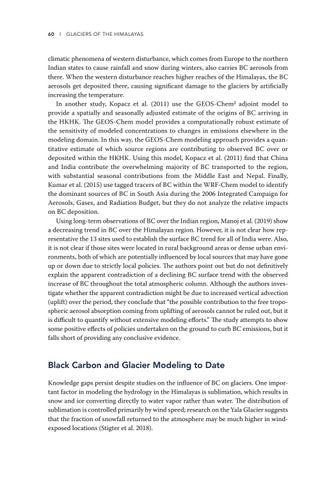60 l Glaciers of the Himalayas
climatic phenomena of western disturbance, which comes from Europe to the northern Indian states to cause rainfall and snow during winters, also carries BC aerosols from there. When the western disturbance reaches higher reaches of the Himalayas, the BC aerosols get deposited there, causing significant damage to the glaciers by artificially increasing the temperature. In another study, Kopacz et al. (2011) use the GEOS-Chem3 adjoint model to provide a spatially and seasonally adjusted estimate of the origins of BC arriving in the HKHK. The GEOS-Chem model provides a computationally robust estimate of the sensitivity of modeled concentrations to changes in emissions elsewhere in the modeling domain. In this way, the GEOS-Chem modeling approach provides a quantitative estimate of which source regions are contributing to observed BC over or deposited within the HKHK. Using this model, Kopacz et al. (2011) find that China and India contribute the overwhelming majority of BC transported to the region, with substantial seasonal contributions from the Middle East and Nepal. Finally, Kumar et al. (2015) use tagged tracers of BC within the WRF-Chem model to identify the dominant sources of BC in South Asia during the 2006 Integrated Campaign for Aerosols, Gases, and Radiation Budget, but they do not analyze the relative impacts on BC deposition. Using long-term observations of BC over the Indian region, Manoj et al. (2019) show a decreasing trend in BC over the Himalayan region. However, it is not clear how representative the 13 sites used to establish the surface BC trend for all of India were. Also, it is not clear if those sites were located in rural background areas or dense urban environments, both of which are potentially influenced by local sources that may have gone up or down due to strictly local policies. The authors point out but do not definitively explain the apparent contradiction of a declining BC surface trend with the observed increase of BC throughout the total atmospheric column. Although the authors investigate whether the apparent contradiction might be due to increased vertical advection (uplift) over the period, they conclude that “the possible contribution to the free tropospheric aerosol absorption coming from uplifting of aerosols cannot be ruled out, but it is difficult to quantify without extensive modeling efforts.” The study attempts to show some positive effects of policies undertaken on the ground to curb BC emissions, but it falls short of providing any conclusive evidence.
Black Carbon and Glacier Modeling to Date Knowledge gaps persist despite studies on the influence of BC on glaciers. One important factor in modeling the hydrology in the Himalayas is sublimation, which results in snow and ice converting directly to water vapor rather than water. The distribution of sublimation is controlled primarily by wind speed; research on the Yala Glacier suggests that the fraction of snowfall returned to the atmosphere may be much higher in windexposed locations (Stigter et al. 2018).




